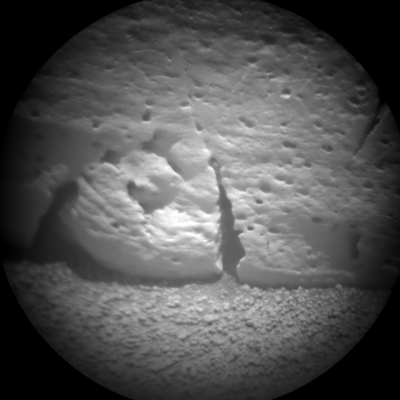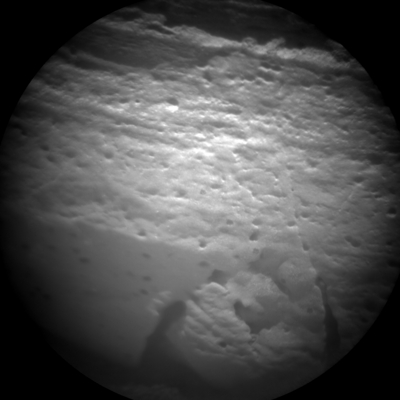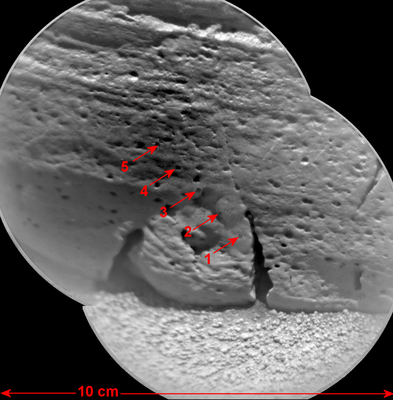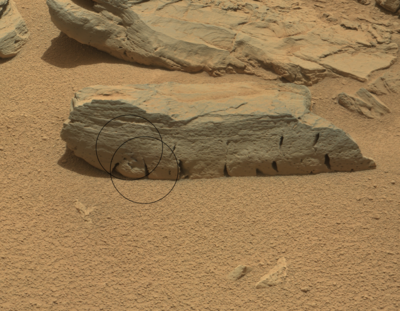
Download:
This was taken on Sol 57 (4 October 2012) of target Rocknest3 using the
ChemCam Remote Micro-Imager (RMI) on the NASA Curiosity rover at a
distance of 3.7 m. The image was downlinked to Earth by ESA's Mars
Express orbiter via the 35m deep space ESTRACK station in New Norcia,
Australia.
This image was taken before a series of five ChemCam Laser-Induced
Breakdown Spectrometer (LIBS) observations. Rocknest is the name of the
area where Curiosity stopped for a month to perform its first mobile
laboratory analyses on soil scooped from a small sand dune. Rocknest3
was a convenient nearby target of which ChemCam made more than thirty
observations overall consisting of 1,500 laser shots; it was also
interrogated by the arm-mounted Alpha Particle X-ray Spectrometer (APXS)
instrument.Credits: NASA/JPL-Caltech/LANL/CNES/IRAP
For the first time, ESA’s Mars orbiter has relayed scientific data from NASA’s Curiosity rover on the Red Planet’s surface. The data included detailed images of ‘Rocknest3’ and were received by ESA’s deep-space antenna in Australia.
It was a small but significant step in interplanetary cooperation between space agencies.
Early on the morning of 6 October, ESA’s Mars Express looked down as
it orbited the planet, lining up its lander communication antenna to
point at Curiosity far below on the surface.
For 15 minutes, the NASA rover transmitted scientific data up to
the ESA satellite. A few hours later, Mars Express slewed to point its
high-gain antenna toward Earth and began downlinking the precious
information to the European Space Operations Centre in Darmstadt,
Germany, via the Agency’s 35 m-diameter antenna in New Norcia,
Australia.
The data were immediately made available to NASA’s Jet Propulsion Laboratory in California for processing and analysis, proving again that NASA’s amazing new rover can talk with Europe’s veteran Mars orbiter.
Curiosity’s ChemCam images Rocknest3
The information included a pair of tremendously interesting images acquired on 4 October by Curiosity’s ChemCam Remote Micro-Imager camera.
ChemCam comprises the camera together with a Laser-Induced Breakdown Spectrometer, which fires a laser at targets and analyses the chemical composition of the vaporised material.
The data were immediately made available to NASA’s Jet Propulsion Laboratory in California for processing and analysis, proving again that NASA’s amazing new rover can talk with Europe’s veteran Mars orbiter.
Curiosity’s ChemCam images Rocknest3
The information included a pair of tremendously interesting images acquired on 4 October by Curiosity’s ChemCam Remote Micro-Imager camera.
ChemCam comprises the camera together with a Laser-Induced Breakdown Spectrometer, which fires a laser at targets and analyses the chemical composition of the vaporised material.
The laser zaps areas smaller than 1 mm across on the surface of
martian rocks and soils, and then the spectrometer provides information
on the minerals and microstructures in the rocks.

Download:
This was taken on
Sol 57 (4 October 2012) of target Rocknest3 using the ChemCam Remote
Micro-Imager (RMI) on the NASA Curiosity rover at a distance of 3.7 m.
The image was downlinked to Earth by ESA's Mars Express orbiter via the
35m deep space ESTRACK station in New Norcia, Australia.
This image was taken after a series of five ChemCam Laser-Induced
Breakdown Spectrometer (LIBS) observations. Rocknest is the name of the
area where Curiosity stopped for a month to perform its first mobile
laboratory analyses on soil scooped from a small sand dune. Rocknest3
was a convenient nearby target of which ChemCam made more than thirty
observations overall consisting of 1,500 laser shots; it was also
interrogated by the arm-mounted Alpha Particle X-ray Spectrometer (APXSI
instrument.
Credits: NASA/JPL-Caltech/LANL/CNES/IRAP
For the first time, ESA’s Mars orbiter has relayed scientific data from
NASA’s Curiosity rover on the Red Planet’s surface. The data included
detailed images of ‘Rocknest3’ and were received by ESA’s deep-space
antenna in Australia.
Outstanding image quality
The first image (at top of article) was taken before a series of five ChemCam laser blasts and the second image (at right) was taken after. The image is centred on the fifth observation point.
“The quality of these images from ChemCam is outstanding, and the
mosaic image of the spectrometer analyses has been essential for
scientific interpretation of the data,” says Sylvestre Maurice, Deputy
Principal Investigator for ChemCam at France’s Research Institute in
Astrophysics and Planetology (IRAP).
“This combination of imaging and analysis has demonstrated its potential for future missions.”

Download:
This mosaic combines the multiple RMI images and indicates the locations of the LIBS laser observations. Credits: NASA/JPL–Caltech/LANL/CNES/IRAP/LPGN/CNRSChemCam laser targets
A third image, relayed separately by NASA, indicates the locations of the laser target points on Rocknest3, as seen by the RMI camera. ‘Rocknest’ is the area where Curiosity stopped for a month to perform its first mobile laboratory analyses on soil scooped from a small sand dune. Rocknest3 was a convenient nearby target where ChemCam made more than 30 observations using 1500 laser shots.
A wide-angle context image was acquired by Curiosity’s MastCam and shows Rocknest3 as targeted by ChemCam. Rocknest3 is about 10 x 40 cm, or roughly the size of a shoe box.

Download:
Context image: The Mastcam 100 colour image shows Rocknest3 targeted by
ChemCam and later by APXS; the fields of view of the RMI images are
indicated. Rocknest3 is approximately 10 x 40 cm or roughly the size of a
shoebox. Credits: NASA/JPL–Caltech/Malin Space Science Systems
During the Curiosity mission, Mars Express is set to provide
additional relay slots, while maintaining its own scientific observation
programme, under an ESA-NASA support agreement.
It can also rapidly provide relay services in case of
unavailability of NASA’s own relay orbiter or if there is a problem on
the rover itself.
Interplanetary cooperation
“ESA–NASA cooperation at Mars is a continuing success, and comes after both sides have worked diligently for a number of years to set technical and engineering standards to enable sharing data between spacecraft, networks and ground stations,” says Mars Express Spacecraft Operations Manager Michel Denis.
Interplanetary cooperation
“ESA–NASA cooperation at Mars is a continuing success, and comes after both sides have worked diligently for a number of years to set technical and engineering standards to enable sharing data between spacecraft, networks and ground stations,” says Mars Express Spacecraft Operations Manager Michel Denis.
“Exploring Mars is a huge challenge, and space agencies are
working to boost cooperation and mutual support for current and upcoming
missions. It’s the way of the future.”
ESA
ESA
Guillermo Gonzalo Sánchez Achutegui
ayabaca@gmail.com
ayabaca@hotmail.com
ayabaca@yahoo.com
Inscríbete en el Foro del blog y participa : A Vuelo De Un Quinde - El Foro!

No hay comentarios:
Publicar un comentario